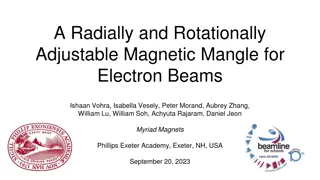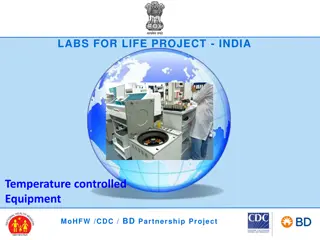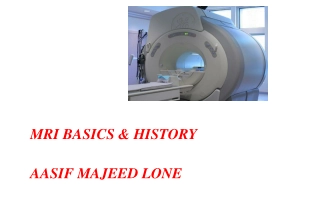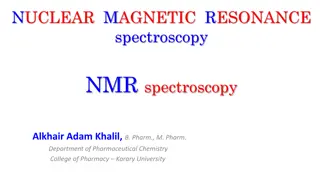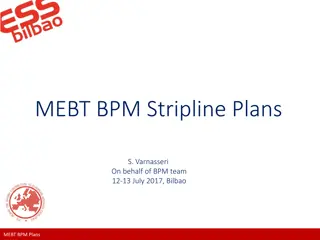Exploring Modern Magnetic Sector Instrument Components in MS Laboratories
Dive into a detailed tour of major components in modern MS labs, including magnets, vacuum pumps, diffusion pumps, turbomolecular pumps, and cryopumps. Learn about the intricate plumbing systems and technology advancements that make MS analysis possible. Discover the specialized equipment and processes used in MS laboratories at renowned institutions like the University of Wisconsin and North Carolina State University.
Download Presentation
Please find below an Image/Link to download the presentation.
The content on the website is provided AS IS for your information and personal use only. It may not be sold, licensed, or shared on other websites without obtaining consent from the author. Download presentation by click this link. If you encounter any issues during the download, it is possible that the publisher has removed the file from their server.
Presentation Transcript
Tour of the Modern Magnetic Sector Instrument student Sector MS-University of Wisconsin Department of Chemistry Inlet plumbing +source (North Carolina State instrument)
Typical modern ms labs-au natural U of Wisconsin NC State Average ms scientist after a few years MS an extremely hardware-bound sport Johns Hopkins
Tour of common major ms components: magnets and Conflat UHV* Stainless steel plumbing Typical plumbing geography Close-up of magnet *UHV=Ultra High Vacuum
Tour of major ms components: vacuum pumps Roughing (mechanical) pump Gas out here Oil in here Schematic of rough pump rotor assembly Note on units: Rough pump moves pressure from 1 mm Hg =1000 0.00001 atm ~ 10 1 atm- 1 mtorr= 1 10-6 atm =0.76 mtorr ~ 1mtorr =1
MS components continued: diffusion pumps From ms manifold Out to rough pump 1000 0.001 Specially made` diffusion pump oil (a stable silicone, e.g. Dow-Corning 701) is heated, misted and rained down through nozzles to entrain gas from ms manifold
MS components continued: alternative to diffusion ..turbomolecularpumps From ms manifold Louvered vanes scoop up gas and guide them out to rough pump Shaft turns at 104 /s Nearly supersonic Turbo pumps are now the dominant choice not greasy and no outgassing problems but $$$ Cutaway of turbo pump
MS components continued: turbomolecular Pumping speed vs pressure Oil diffusion begins to lose it here Turbos rated down to10-6 1 1000 Start of UHV (ultra high vacuum range: 10-8 atm)
MS components continued: other pump types Cryopump Fill cooling loop with refrigerant (liq. N2) and freeze out condensable gases on outside of loops To rough pump (takes out air) Achieves ~ 0.01-0.001
MS components continued: other pump types (continued) Titanium sublimation pump (also called a getter pump) two basic parts: 3) Achieves 0.001 u ? 2)Reactive residual gases not pumped away by rough pump are reacted on baffle surface B) Getter surface A) Ti sublimation source 1) Ti is sputtered from three hair pin loops of Ti
MS components continued: other pump types (continued) Ion trap collector Ion pumps 4) 10-10 (0.01 -0.0001 ) 10-12 atm (+) 1)Best choice for UHV work: 3)or collected at anode trap 2)Ions formed from impact of electrons which are gettered
MS components continued: vacuum gauges Thermocouple gauge Good from 1 atm-10 u Thermocouple junction measures variation of temperature created by residual gases and converts to volts measured at (M) Produces constant T at reference side Poor chemist universal P gauge $ 50 (without electronic amplifier)
MS components continued: vacuum gauges cathode Phillips-Granville high vacuum gauge Conductance measured here 1)Works by sending a current across space between anode wire and cathode loop anode and at fixed (high) voltage measuring conductance Measures down 10-6 u (also called simply: ion gauge $1000/tube)
MS components continued: Electron impact (EI) source Various designs from HP, Thermoelectron and Perkin-Elmer
MS components continued: Electron impact (EI) source (cont.) SOURCE BLOCK Magnets used to focus beam and inject into ion accelerator* otherwise ions will wander like sheep
MS components continued: Electron impact (EI) source (cont.) This piece caled the ION or MASS ACCELERATOR or `ION OPTICS Ions created and focused out of source block slit are accelerated through a series of +/- plates Addendum: `accelerator to produce fixed velocities .tied to net voltage V across +/- plates (~ variac control )
The MS Body parts game Where is the `detector ? Where is the vacuum pump? Where is ion source? First ion source a stick shape 1st detector: Kodak 35 mm film records spectrum Mechanical pump
Find the source game White ceramic back cap is a hint
MS parts game (cont.) ion acceleration (optics) 1)Find pumps magnet 2)Find magnet or (probably) source (or TC gauge ?) 4) Find ion source Diffusion pumps 3) Find ion optics (accelerator)
MS components continued: dynode detector design Original electron dynode multiplier design: emissive plates at angles Compact version of dynode multiplier Gain factor is 106 1012
Summary of bits and pieces Pump types Gauge types *Mechanical 1 atm -10 Cryopumps 10-0.01 *Thermocouple1 atm-10 Pirani gauge 100-0.1 Diffusion 1000-0.001 Phillips ion gauge10 u ---0.00001 *Turbomolecular 10-0.0001 Ti sublimation 10 -0.01 Ion pump 1-0.00001 Most common source *EI = Electron Impact Most common detector *Red colored componentsin Alfred instruments *Dynode multiplier (Rheodyne) (HP has diffusion pump; INCOS has turbo pump)
A few more MS bits & pieces: other designs and approaches Alternative to dynode detector FARADAY CUP Can also be voltage amplifier (op amp) Detector pod Faraday cage (keeps all charges inside)
A few more MS bits & pieces (continued) Alternative to magnetic sector: quadrupole design Pros Smaller Cheaper Stable Rugged Cons Tuning is tricky Resolution Alfred MS is quadrupole See text for description of control issues
A few more MS bits & pieces (continued) Pros (vs quadrupole) Even cheaper alternative: Time-of-Flight (TOF) Even smaller than quadrupole (no magnets at all !) ~ 1 foot1 Con (vs quadrupole) 1 even smaller than original Aston MS Resolution only 1 amu (lousy)
A few more MS bits & pieces (continued) Traditional MS inlet designs Direct probe Indirect gas inlet
EI GC-MS inlet system Sample injection here * GC oven * Sample M MS chamber Quad head (w/ion optics) He Transfer line (heated) Capillary column Quad rods M+ (*) To detector
MS Designs compared Resolution = R= M/ M Example R= 32 = 320 0.1 forM=32 amu M=0.1 amu=> Design feature Magnetic sector Quadrupole TOF R Max 20,000 Max 2000 Max <500 $ 300-500 k$ 75-100 k$ 20-30 k$ Size Need whole room 1-2 bench tops bench top research Forensics, analytical chem, environment, education Industry, limited species use











